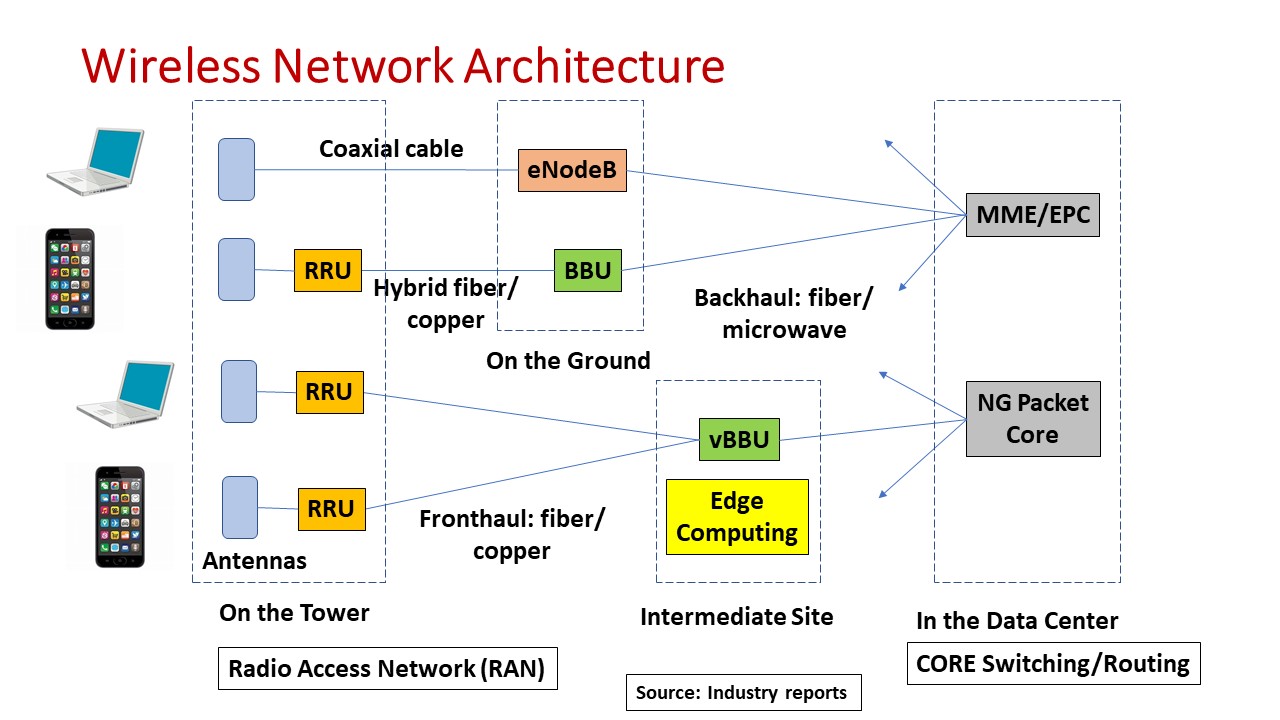Cloud-based, software-enabled functions greatly reduce operating costs and improve efficiencies in running wireless networks. On the surface, the economic benefits that come with virtualized wireless networks are quite compelling. That said, the need for the basic elements that make up the radio access network (RAN) is not going away.
It’s still RF after all. Greenfield network developments such as Rakuten in Japan and DISH Networks in the U.S. are relying heavily on virtualized network designs to build large scale, wireless networks faster and at lower capital expenditures (capex) compared to traditional wireless network architecture. How fast and how much cheaper is to be determined. But it’s worth taking a look.
The chart shows the evolution from a traditional wireless network topology (top) to a virtual network (bottom). 3G base station radios or 4G eNodeB’s are installed in a hut or shelter at base of a tower, and fed RF energy over coaxial cable to antennas at the top of the tower. The antennas broadcast the signals over the air to mobile devices. A backhaul connection over either fiber optic cable or microwave radio send baseband signals to and from the Mobile Management Element (MME) and the Evolved Packet Core (EPC) to process voice and data calls and switch or route them over the cellular network to other devices or to the internet. Long coaxial runs between radios and antennas added weight to towers and caused signal strength losses between the radios and the antennas.
A solution was to split the eNodeB into a remote radio unit (RRU) and a base band unit (BBU). The RRU handles the RF signals. It is installed on the tower and connected to the antennas by a coaxial cable jumper. The BBU is housed in a shelter or hut on the ground and feeds IP signals to the RRU over a fiber cable. A copper cable powers the RRUs from the ground. BBUs connect to the EPC over a backhaul link. Once separated, new topologies were developed to centralize the BBU functions to serve multiple RRUs in a number of sites. New concepts like centralized RAN (cRAN) introduced the idea that a lot of the baseband processing functions (network element management, operations/billings support systems, multi-media traffic handling) could be centralized in a data center or intermediate hub and distributed to any number of sites.
With 5G, the concept of virtualization is being taken even further where RRUs are software-controlled, open source programmable elements that are no longer proprietary to the established equipment manufacturers. More important, signal processing takes place in the cloud but critical functions are highly distributed with computing pushed to the edge of the network. Edge computing drives operating efficiencies and enables at lower costs the delivery of new 5G services for vertical market applications and use cases.
Various market studies suggest that a vRAN approach can reduce capital expenditures (capex) for RAN equipment by over 40 percent compared to conventional RAN deployments, Moreover, vRAN efficiencies can lead to operating expense (opex) reductions in the 60 percent range. These estimates have yet to pan out but are promising nonetheless.
Network deployment costs are not likely to scale back appreciably, however. The same methods and processes used today will be needed for 5G microcell and small cell site acquisition, permitting, licensing and site construction. Arguments are being advanced that a simpler network scheme is easier to install in shorter timeframes than conventional networks. That remains to be seen.
Network virtualization can benefit the service providers with improved operating efficiencies and favorable economic returns. The big questions is: Can the service providers afford the billions of dollars it will take to make virtualization a reality?
By John Celentano, Inside Towers Business Editor





Reader Interactions